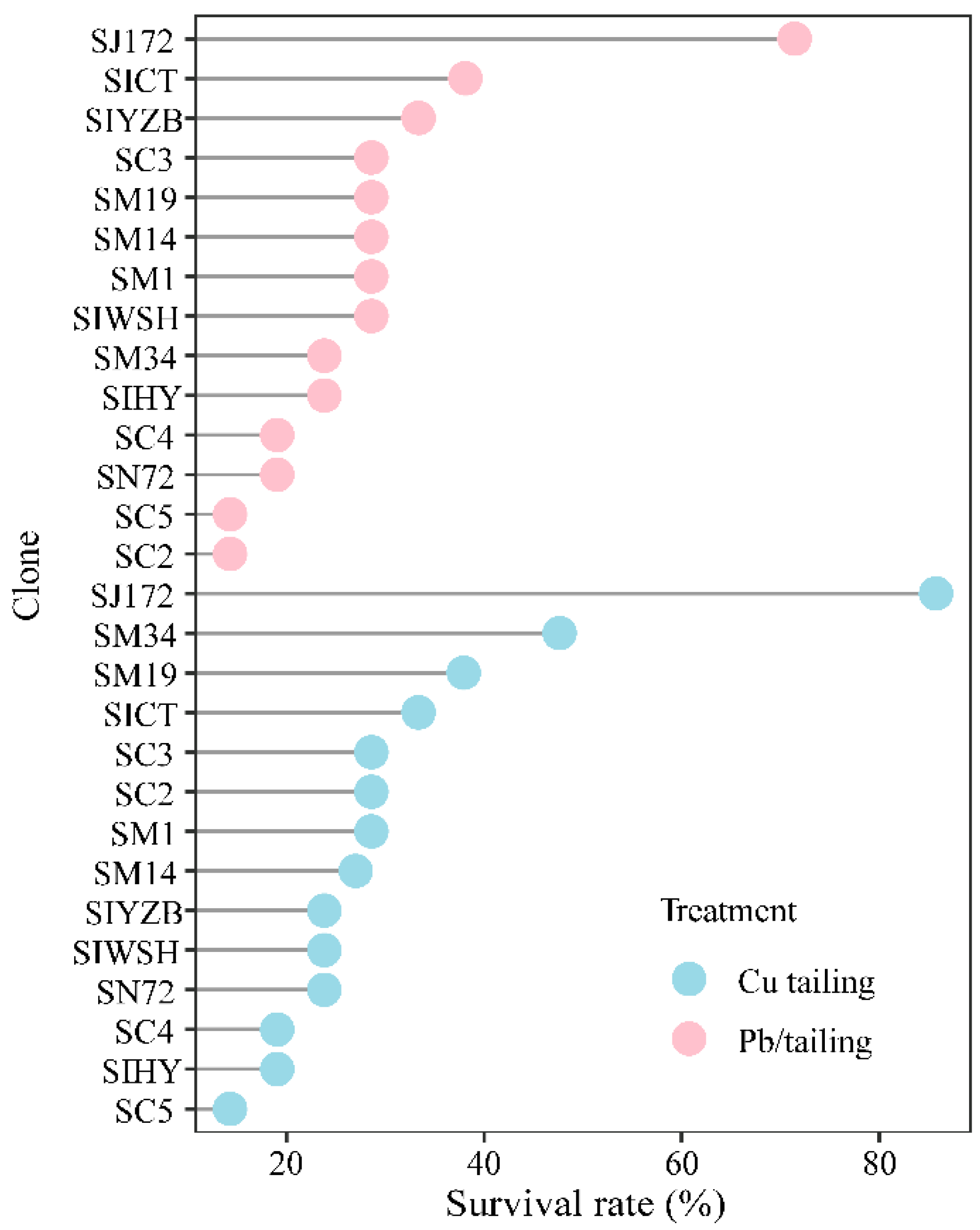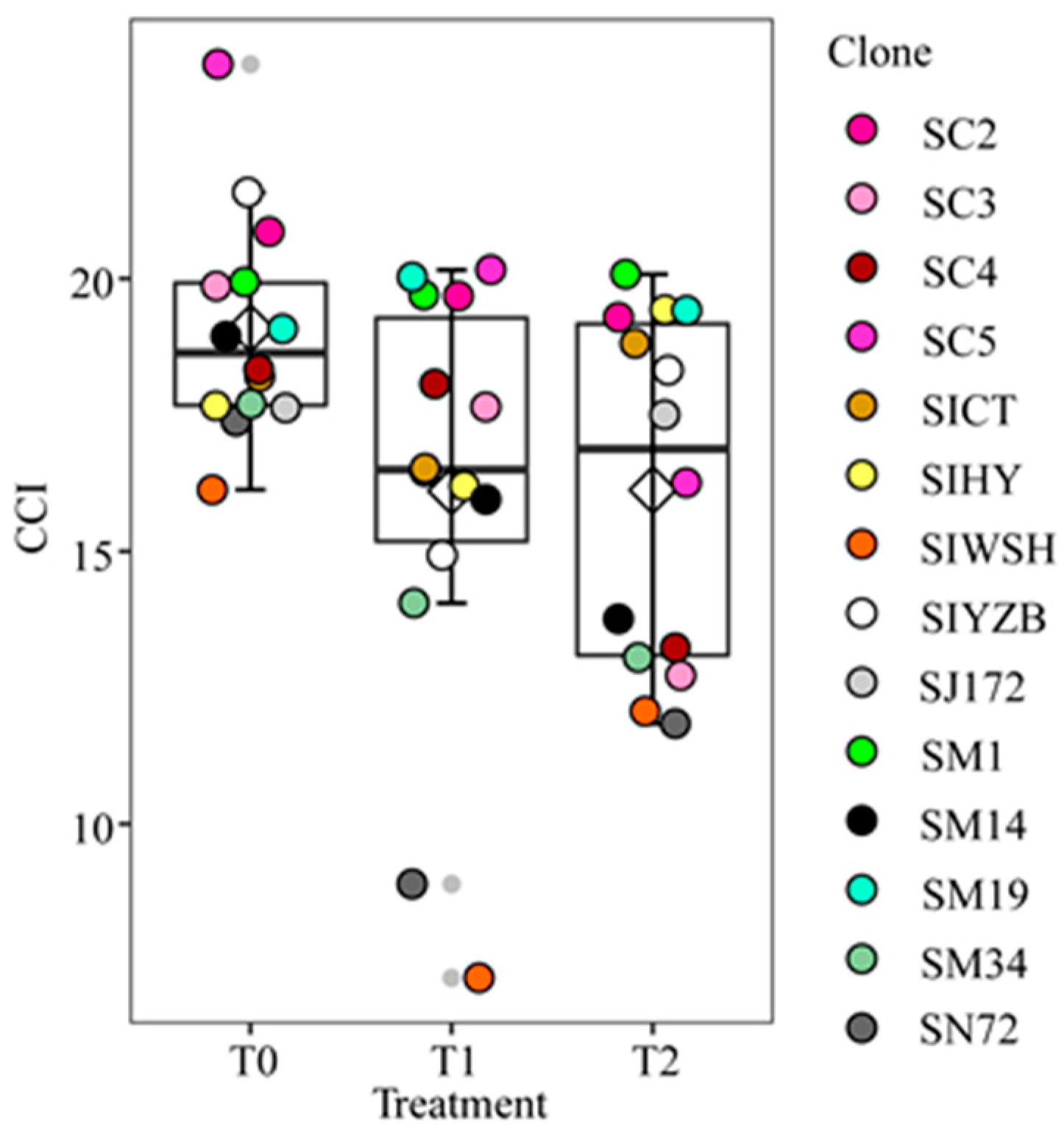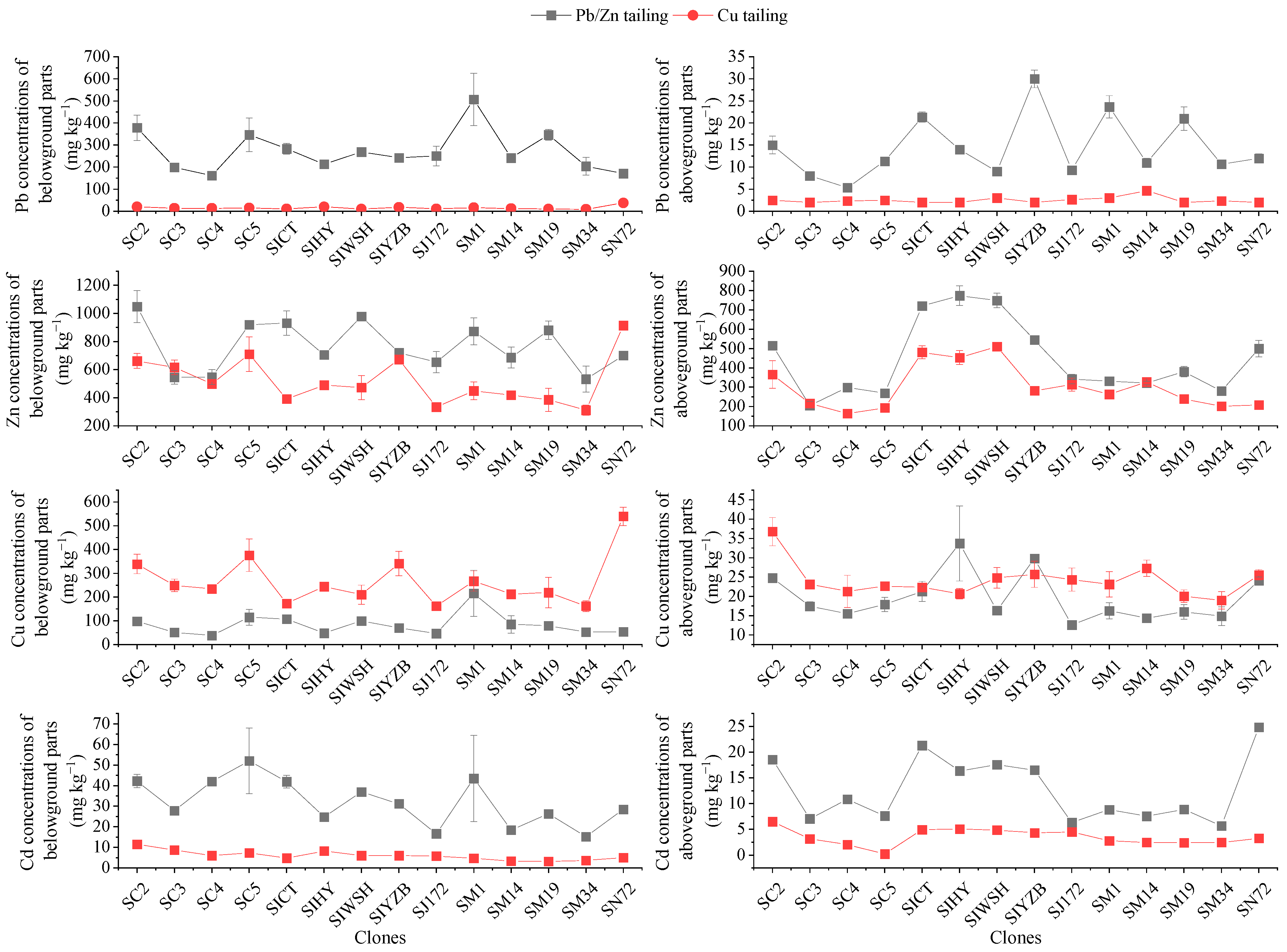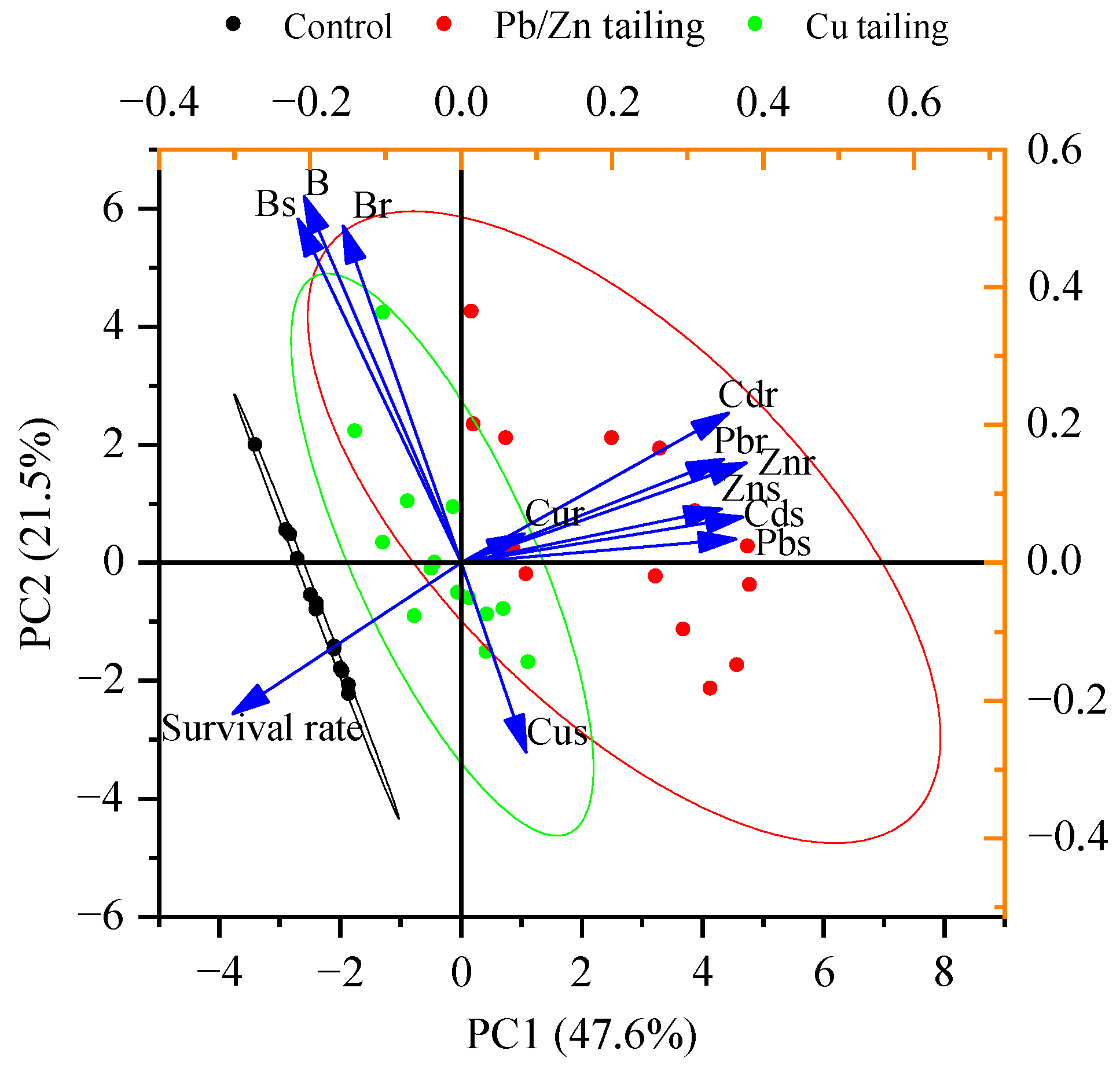The Phytoremediation Potential of 14 Salix Clones Grown in Pb/Zn and Cu Mine Tailings
Abstract
:1. Introduction
2. Materials and Methods
2.1. Site Description and Tailing Materials
2.2. Plant Materials
2.3. Experiment Methods
2.4. Biomass Measurements
2.5. Estimation of Chlorophyll Content
2.6. Plant Sampling and Chemical Analysis
2.7. Tailing Property Measurements
2.8. Statistical Analysis
3. Results
3.1. Cutting Survival
3.2. Biomass
3.3. Chlorophyll Concentration Index
3.4. Accumulation and Translocation of Metals in the Cuttings
3.5. PCA Analysis and Evaluation of Phytoremediation Potential
4. Discussion
4.1. Variation in the Survival Rate and Biomass Production
4.2. Heavy Metals Accumulation in Willow Tissues
4.3. Potential for Phytoremediation
5. Conclusions
Supplementary Materials
Author Contributions
Funding
Data Availability Statement
Conflicts of Interest
References
- Wang, J.; Delavar, M.A. Techno-economic analysis of phytoremediation: A strategic rethinking. Sci. Total Environ. 2023, 902, 165949. [Google Scholar] [CrossRef] [PubMed]
- Lago-Vila, M.; Arenas-Lago, D.; Rodríguez-Seijo, A.; Andrade, M.L.; Vega, F.A. Ability of Cytisus scoparius for phytoremediation of soils from a Pb/Zn mine: Assessment of metal bioavailability and bioaccumulation. J. Environ. Manag. 2019, 235, 152–160. [Google Scholar] [CrossRef] [PubMed]
- Midhat, L.; Ouazzani, N.; Hejjaj, A.; Ouhammou, A.; Mandi, L. Accumulation of heavy metals in metallophytes from three mining sites (Southern Centre Morocco) and evaluation of their phytoremediation potential. Ecotox. Environ. Saf. 2019, 169, 150–160. [Google Scholar] [CrossRef]
- Charvalas, G.; Solomou, A.D.; Giannoulis, K.D.; Skoufogianni, E.; Bartzialis, D.; Emmanouil, C.; Danalatos, N.G. Determination of heavy metals in the territory of contaminated areas of Greece and their restoration through hyperaccumulators. Environ. Sci. Pollut. Res. 2021, 28, 3858–3863. [Google Scholar] [CrossRef]
- Mendez, M.O.; Maier, R.M. Phytostabilization of mine tailings in arid and semiarid environments-an emerging remediation technology. Environ. Health Persp. 2007, 116, 278–283. [Google Scholar] [CrossRef] [PubMed]
- Lenart-Boroń, A.; Wolny-Koładka, K. Heavy metal concentration and the occurrence of selected microorganisms in soils of a steelworks area in Poland. Plant Soil Environ. 2015, 61, 273–278. [Google Scholar] [CrossRef]
- Wu, Y.; Li, X.; Yu, L.; Wang, T.; Wang, J.; Liu, T. Review of soil heavy metal pollution in China: Spatial distribution, primary sources, and remediation alternatives. Resour. Conserv. Recy. 2022, 181, 106261. [Google Scholar] [CrossRef]
- Yang, L.; Wang, J.; Yang, Y.; Li, S.; Wang, T.; Oleksak, P.; Chrienova, Z.; Wu, Q.; Nepovimova, E.; Zhang, X. Phytoremediation of heavy metal pollution: Hotspots and future prospects. Ecotox. Environ. Saf. 2022, 234, 113403. [Google Scholar] [CrossRef]
- Gurajala, H.K.; Cao, X.R.; Tang, L.; Ramesh, T.M.; Lu, M.; Yang, X.E. Comparative assessment of Indian mustard (Brassica juncea L.) genotypes for phytoremediation of Cd and Pb contaminated soils. Environ. Pollut. 2019, 254, 113085. [Google Scholar] [CrossRef]
- Lin, H.; Zhang, X.H.; Chen, J.; Liang, L.; Liu, L.H. Phytoremediation potential of Leersia hexandra Swartz of copper contaminated soil and its enhancement by using agronomic management practices. Ecol. Eng. 2019, 127, 561–566. [Google Scholar] [CrossRef]
- Tang, C.F.; Chen, Y.H.; Zhang, Q.N.; Li, J.B.; Zhang, F.Y.; Liu, Z.M. Effects of peat on plant growth and lead and zinc phytostabilization from lead-zinc mine tailing in southern China: Screening plant species resisting and accumulating metals. Ecotox. Environ. Saf. 2019, 176, 42–49. [Google Scholar] [CrossRef] [PubMed]
- Álvarez-Mateos, P.; Alés-Álvarez, F.-J.; García-Martín, J.F. Phytoremediation of highly contaminated mining soils by Jatropha curcas L. and production of catalytic carbons from the generated biomass. J. Environ. Manag. 2019, 231, 886–895. [Google Scholar] [CrossRef] [PubMed]
- Tang, K.H.D. Phytoremediation: Where do we go from here? Biocatal. Agric. Biotechnol. 2023, 50, 102721. [Google Scholar] [CrossRef]
- Tan, H.W.; Pang, Y.L.; Lim, S.; Chong, W.C. A state-of-the-art of phytoremediation approach for sustainable management of heavy metals recovery. Environ. Technol. Innov. 2023, 30, 103043. [Google Scholar] [CrossRef]
- Yang, W.; Liu, D.; Wang, Y.; Hussain, B.; Zhao, F.; Ding, Z.; Yang, X.; Zhu, Z.; Dawood, M. Variations in phytoremediation potential and phytoavailability of heavy metals in different Salix genotypes subjected to seasonal flooding. J. Environ. Manag. 2021, 299, 113632. [Google Scholar] [CrossRef]
- Elshamy, M.M.; Heikal, Y.M.; Bonanomi, G. Phytoremediation efficiency of Portulaca oleracea L. naturally growing in some industrial sites, Dakahlia District, Egypt. Chemosphere 2019, 225, 678–687. [Google Scholar] [CrossRef]
- Pilipović, A.; Zalesny Jr, R.S.; Rončević, S.; Nikolić, N.; Orlović, S.; Beljin, J.; Katanić, M. Growth, physiology, and phytoextraction potential of poplar and willow established in soils amended with heavy-metal contaminated, dredged river sediments. J. Environ. Manag. 2019, 239, 352–365. [Google Scholar] [CrossRef]
- Cao, Y.N.; Zhang, Y.; Ma, C.X.; Li, H.M.; Zhang, J.F.; Chen, G.C. Growth, physiological responses, and copper accumulation in seven willow species exposed to Cu-a hydroponic experiment. Environ. Sci. Pollut. Res. 2018, 25, 19875–19886. [Google Scholar] [CrossRef] [PubMed]
- Zalesny, R.S.; Stanturf, J.A.; Gardiner, E.S.; Bañuelos, G.S.; Hallett, R.A.; Hass, A.; Stange, C.M.; Perdue, J.H.; Young, T.M.; Coyle, D.R. Environmental technologies of woody crop production systems. BioEnerg. Res. 2016, 9, 492–506. [Google Scholar] [CrossRef]
- Touati, M.; Bottega, S.; Castiglione, M.R.; Sorce, C.; Béjaoui, Z.; Spanò, C. Modulation of the defence responses against Cd in willow species through a multifaceted analysis. Plant Physiol. Bioch. 2019, 142, 125–136. [Google Scholar] [CrossRef] [PubMed]
- Cao, Y.; Tan, Q.; Zhang, F.; Ma, C.; Xiao, J.; Chen, G. Phytoremediation potential evaluation of multiple Salix clones for heavy metals (Cd, Zn and Pb) in flooded soils. Sci. Total Environ. 2022, 813, 152482. [Google Scholar] [CrossRef]
- Mleczek, M.; Rutkowski, P.; Rissmann, I.; Kaczmarek, Z.; Golinski, P.; Szentner, K.; Strażyńska, K.; Stachowiak, A. Biomass productivity and phytoremediation potential of Salix alba and Salix viminalis. Biomass Bioenerg. 2010, 34, 1410–1418. [Google Scholar] [CrossRef]
- Kuzovkina, Y.A.; Volk, T.A. The characterization of willow (Salix L.) varieties for use in ecological engineering applications: Co-ordination of structure, function and autecology. Ecol. Eng. 2009, 35, 1178–1189. [Google Scholar] [CrossRef]
- Jensen, J.K.; Holm, P.E.; Nejrup, J.; Larsen, M.B.; Borggaard, O.K. The potential of willow for remediation of heavy metal polluted calcareous urban soils. Environ. Pollut. 2009, 157, 931–937. [Google Scholar] [CrossRef]
- Sylvain, B.; Mikael, M.-H.; Florie, M.; Emmanuel, J.; Marilyne, S.; Sylvain, B.; Domenico, M. Phytostabilization of As, Sb and Pb by two willow species (S. viminalis and S. purpurea) on former mine technosols. Catena 2016, 136, 44–52. [Google Scholar] [CrossRef]
- Mleczek, M.; Gąsecka, M.; Waliszewska, B.; Magdziak, Z.; Szostek, M.; Rutkowski, P.; Kaniuczak, J.; Zborowska, M.; Budzyńska, S.; Mleczek, P. Salix viminalis L.-A highly effective plant in phytoextraction of elements. Chemosphere 2018, 212, 67–78. [Google Scholar] [CrossRef] [PubMed]
- Vyslouzilova, M.; Tlustos, P.; Száková, J. Cadmium and zinc phytoextraction potential of seven clones of Salix spp. planted on heavy metal contaminated soils. Plant Soil Environ. 2003, 49, 542–547. [Google Scholar] [CrossRef]
- Dickinson, N.M.; Pulford, I.D. Cadmium phytoextraction using short-rotation coppice Salix: The evidence trail. Environ. Int. 2005, 31, 609–613. [Google Scholar] [CrossRef] [PubMed]
- Cao, Y.N.; Ma, C.X.; Chen, G.C.; Zhang, J.F.; Xing, B.S. Physiological and biochemical responses of Salix integra Thunb. under copper stress as affected by soil flooding. Environ. Pollut. 2017, 225, 644–653. [Google Scholar] [CrossRef]
- Salam, M.M.A.; Mohsin, M.; Pulkkinen, P.; Pelkonen, P.; Pappinen, A. Effects of soil amendments on the growth response and phytoextraction capability of a willow variety (S. viminalis× S. schwerinii× S. dasyclados) grown in contaminated soils. Ecotox. Environ. Saf. 2019, 171, 753–770. [Google Scholar] [CrossRef]
- Mohsin, M.; Salam, M.M.A.; Nawrot, N.; Kaipiainen, E.; Lane, D.J.; Wojciechowska, E.; Kinnunen, N.; Heimonen, M.; Tervahauta, A.; Peräniemi, S. Phytoextraction and recovery of rare earth elements using willow (Salix spp.). Sci. Total Environ. 2022, 809, 152209. [Google Scholar] [CrossRef]
- Wahsha, M.; Bini, C.; Argese, E.; Minello, F.; Fontana, S.; Wahsheh, H. Heavy metals accumulation in willows growing on Spolic Technosols from the abandoned Imperina Valley mine in Italy. J. Geochem. Explor. 2012, 123, 19–24. [Google Scholar] [CrossRef]
- Sandhi, A.; Gao, L.; Rosenlund, J.; Landberg, T. Growing Salix spp. on heavy metal contaminated sediment (Oskarshamn, Sweden) as a joint phytoremediation and circular economy approach. Environ. Adv. 2023, 14, 100438. [Google Scholar] [CrossRef]
- Mleczek, M.; Rissmann, I.; Rutkowski, P.; Kaczmarek, Z.; Golinski, P. Accumulation of selected heavy metals by different genotypes of Salix. Environ. Exp. Bot. 2009, 66, 289–296. [Google Scholar] [CrossRef]
- Zhivotovsky, O.P.; Kuzovkina, J.A.; Schulthess, C.P.; Morris, T.; Pettinelli, D.; Ge, M. Hydroponic screening of willows (Salix L.) for lead tolerance and accumulation. Int. J. Phytoremediat. 2010, 13, 75–94. [Google Scholar] [CrossRef]
- Wang, S.; Volk, T.A.; Xu, J. Variability in growth and cadmium accumulation capacity among willow hybrids and their parents: Implications for yield-based selection of Cd-efficient cultivars. J. Environ. Manag. 2021, 299, 113643. [Google Scholar] [CrossRef] [PubMed]
- Karp, A.; Hanley, S.J.; Trybush, S.O.; Macalpine, W.; Pei, M.; Shield, I. Genetic improvement of willow for bioenergy and biofuels free access. J. Integr. Plant Biol. 2011, 53, 151–165. [Google Scholar] [CrossRef]
- Wang, S.F.; Shi, X.; Sun, H.J.; Chen, Y.T.; Pan, H.W.; Yang, X.E.; Rafiq, T. Variations in metal tolerance and accumulation in three hydroponically cultivated varieties of Salix integra treated with lead. PLoS ONE 2014, 9, e108568. [Google Scholar] [CrossRef] [PubMed]
- Yang, W.D.; Ding, Z.L.; Zhao, F.L.; Wang, Y.Y.; Zhang, X.C.; Zhu, Z.Q.; Yang, X.E. Comparison of manganese tolerance and accumulation among 24 Salix clones in a hydroponic experiment: Application for phytoremediation. J. Geochem. Explor. 2015, 149, 1–7. [Google Scholar] [CrossRef]
- Yang, W.D.; Zhao, F.L.; Zhang, X.C.; Ding, Z.L.; Wang, Y.Y.; Zhu, Z.Q.; Yang, X.E. Variations of cadmium tolerance and accumulation among 39 Salix clones: Implications for phytoextraction. Environ. Earth Sci. 2015, 73, 3263–3274. [Google Scholar] [CrossRef]
- Chen, G.C.; Liu, Z.K.; Zhang, J.F.; Owens, G. Phytoaccumulation of copper in willow seedlings under different hydrological regimes. Ecol. Eng. 2012, 44, 285–289. [Google Scholar] [CrossRef]
- Chen, G.C.; Liu, Y.Q.; Wang, R.M.; Zhang, J.F.; Owens, G. Cadmium adsorption by willow root: The role of cell walls and their subfractions. Environ. Sci. Pollut. Res. 2013, 20, 5665–5672. [Google Scholar] [CrossRef] [PubMed]
- Beauchamp, S.; Jerbi, A.; Frenette-Dussault, C.; Pitre, F.E.; Labrecque, M. Does the origin of cuttings influence yield and phytoextraction potential of willow in a contaminated soil? Ecol. Eng. 2018, 111, 125–133. [Google Scholar] [CrossRef]
- GB15618-2018; Soil Environment Quality Risk Control Standard for Soil Contamination of Agriculture Land. Ministry of Ecological Environment of the People’s Republic of China, State Administration for Market Regulation, China Environment Publishing Group: Beijing, China, 2019; p. 2.
- Fernández-Braña, A.; Salgado, L.; Gallego, J.L.R.; Afif, E.; Boente, C.; Forján, R. Phytoremediation potential depends on the degree of soil pollution: A case study in an urban brownfield. Environ. Sci. Pollut. Res. 2023, 30, 67708–67719. [Google Scholar] [CrossRef]
- Bao, S.D. Soil and Agricultural Chemistry Analysis, 3rd ed.; China Agriculture Press: Beijing, China, 2000; pp. 30–108. [Google Scholar]
- Li, X.; Xiao, J.; Salam, M.M.A.; Chen, G. Evaluation of dendroremediation potential of ten Quercus spp. for heavy metals contaminated soil: A three-year field trial. Sci. Total Environ. 2022, 851, 158232. [Google Scholar] [CrossRef] [PubMed]
- Wang, W.W.; Ke Cheng, L.; Hao, J.W.; Guan, X.; Tian, X.J. Phytoextraction of initial cutting of Salix matsudana for Cd and Cu. Int. J. Phytoremediat. 2019, 21, 84–91. [Google Scholar] [CrossRef]
- Mahawar, L.; Popek, R.; Shekhawat, G.S.; Alyemeni, M.N.; Ahmad, P. Exogenous hemin improves Cd2+ tolerance and remediation potential in Vigna radiata by intensifying the HO-1 mediated antioxidant defence system. Sci. Rep. 2021, 11, 2811. [Google Scholar] [CrossRef]
- Castiglione, S.; Todeschini, V.; Franchin, C.; Torrigiani, P.; Gastaldi, D.; Cicatelli, A.; Rinaudo, C.; Berta, G.; Biondi, S.; Lingua, G. Clonal differences in survival capacity, copper and zinc accumulation, and correlation with leaf polyamine levels in poplar: A large-scale field trial on heavily polluted soil. Environ. Pollut. 2009, 157, 2108–2117. [Google Scholar] [CrossRef] [PubMed]
- Salam, M.M.A.; Kaipiainen, E.; Mohsin, M.; Villa, A.; Kuittinen, S.; Pulkkinen, P.; Pelkonen, P.; Mehtätalo, L.; Pappinen, A. Effects of contaminated soil on the growth performance of young Salix (Salix schwerinii EL Wolf) and the potential for phytoremediation of heavy metals. J. Environ. Manag. 2016, 183, 467–477. [Google Scholar] [CrossRef]
- Kabata-Pendias, A. Trace Elements in Soils and Plants, 4th ed.; CRC Press: Boca Raton, FL, USA, 2000; p. 105. [Google Scholar]
- Levy, D.; Redente, E.; Uphoff, G. Evaluating the phytotoxicity of Pb-Zn tailings to big bluestem (Andropogon gerardii Vitman) and switchgrass (Panicum virgatum L.). Soil Sci. 1999, 164, 363–375. [Google Scholar] [CrossRef]
- Yang, W.D.; Yang, Y.; Ding, Z.L.; Yang, X.E.; Zhao, F.L.; Zhu, Z.Q. Uptake and accumulation of cadmium in flooded versus non-flooded Salix genotypes: Implications for phytoremediation. Ecol. Eng. 2019, 136, 79–88. [Google Scholar] [CrossRef]
- Weih, M. Evidence for increased sensitivity to nutrient and water stress in a fast-growing hybrid willow compared with a natural willow clone. Tree Physiol. 2001, 21, 1141–1148. [Google Scholar] [CrossRef]
- Algreen, M.; Trapp, S.; Rein, A. Phytoscreening and phytoextraction of heavy metals at Danish polluted sites using willow and poplar trees. Environ. Sci. Pollut. Res. 2014, 21, 8992–9001. [Google Scholar] [CrossRef] [PubMed]
- Tőzsér, D.; Magura, T.; Simon, E. Heavy metal uptake by plant parts of willow species: A meta-analysis. J. Hazard. Mater. 2017, 336, 101–109. [Google Scholar] [CrossRef] [PubMed]
- Kim, H.-T.; Kim, J.G. Seasonal variations of metal (Cd, Pb, Mn, Cu, Zn) accumulation in a voluntary species, Salix subfragilis, in unpolluted wetlands. Sci. Total Environ. 2018, 610, 1210–1221. [Google Scholar] [CrossRef]
- Xu, X.H.; Yang, B.S.; Qin, G.H.; Wang, H.; Zhu, Y.D.; Zhang, K.Z.; Yang, H.Q. Growth, accumulation, and antioxidative responses of two Salix genotypes exposed to cadmium and lead in hydroponic culture. Environ. Sci. Pollut. Res. 2019, 26, 19770–19784. [Google Scholar] [CrossRef]
- Bolan, N.; Kunhikrishnan, A.; Thangarajan, R.; Kumpiene, J.; Park, J.; Makino, T.; Kirkham, M.B.; Scheckel, K. Remediation of heavy metal (loid) s contaminated soils–to mobilize or to immobilize? J. Hazard. Mater. 2014, 266, 141–166. [Google Scholar] [CrossRef] [PubMed]
- Mendez, M.O.; Maier, R.M. Phytoremediation of mine tailings in temperate and arid environments. Rev. Environ. Sci. Biotechnol. 2008, 7, 47–59. [Google Scholar] [CrossRef]
- Liu, Y.; Wang, Y.; Lu, H.; Lonappan, L.; Brar, S.K.; He, L.; Chen, J.; Yang, S. Biochar application as a soil amendment for decreasing cadmium availability in soil and accumulation in Brassica chinensis. J. Soil. Sediments 2018, 18, 2511–2519. [Google Scholar] [CrossRef]
- Landberg, T.; Greger, M. Interclonal variation of heavy metal interactions in Salix viminalis. Environ. Toxicol. Chem. 2002, 21, 2669–2674. [Google Scholar] [CrossRef]
- de Souza, S.C.R.; de Andrade, S.A.L.; de Souza, L.A.; Schiavinato, M.A. Lead tolerance and phytoremediation potential of Brazilian leguminous tree species at the seedling stage. J. Environ. Manag. 2012, 110, 299–307. [Google Scholar] [CrossRef] [PubMed]
- Wieshammer, G.; Unterbrunner, R.; García, T.B.; Zivkovic, M.F.; Puschenreiter, M.; Wenzel, W.W. Phytoextraction of Cd and Zn from agricultural soils by Salix ssp. and intercropping of Salix caprea and Arabidopsis halleri. Plant Soil 2007, 298, 255–264. [Google Scholar] [CrossRef]
- Shi, X.; Wang, S.F.; Sun, H.J.; Chen, Y.T.; Wang, D.X.; Pan, H.W.; Zou, Y.Z.; Liu, J.F.; Zheng, L.Y.; Zhao, X.L. Comparative of Quercus spp. and Salix spp. for phytoremediation of Pb/Zn mine tailings. Environ. Sci. Pollut. Res. 2017, 24, 3400–3411. [Google Scholar] [CrossRef] [PubMed]
- Punshon, T.; Dickinson, N.M. Acclimation of Salix to metal stress. New Phytol. 1997, 137, 303–314. [Google Scholar] [CrossRef]






| River Sand | Pb/Zn Tailing | Cu Tailing | |
|---|---|---|---|
| Pb (mg kg−1) | 238 | 5850 | 108 |
| Zn (mg kg−1) | 370 | 9980 | 1440 |
| Cu (mg kg−1) | 11 | 186 | 1450 |
| CD (mg kg−1) | 0.85 | 51.2 | 6.2 |
| Hydrolysable N (mg kg−1) | 2 | 1 | 6 |
| Available P(mg kg−1) | 17.4 | 11.1 | 10.9 |
| Rapidly available K (mg kg−1) | 34.9 | 36.4 | 52.1 |
| Organic matter (g kg−1) | 0.15 | 4.29 | 1.38 |
| pH | 8.12 | 7.59 | 7.92 |
| Clone ID | Species/Hybrid | Abbreviation | Origin |
|---|---|---|---|
| 172 | Salix jiangsuensis | SJ172 | Jiangsu provinces |
| 72 | Salix nigra | SN72 | United States |
| HY | Salix integra | SIHY | Shandong provinces |
| CT | Salix integra | SICT | Shandong provinces |
| WSH | Salix integra | SIWSH | Shandong provinces |
| YZB | Salix integra | SIYZB | Shandong provinces |
| 1 | Salix matsudana | SM1 | Zhejiang provinces |
| 14 | Salix matsudana | SM14 | Zhejiang provinces |
| 19 | Salix matsudana | SM19 | Zhejiang provinces |
| 34 | Salix matsudana | SM34 | Zhejiang provinces |
| 2 | Salix chaenomeloides | SC2 | Zhejiang provinces |
| 3 | Salix chaenomeloides | SC3 | Zhejiang provinces |
| 4 | Salix chaenomeloides | SC4 | Zhejiang provinces |
| 5 | Salix chaenomeloides | SC5 | Zhejiang provinces |
| Clones | TOPSIS | CBAI | ||||||
|---|---|---|---|---|---|---|---|---|
| Pb/Zn Mine Tailing | Cu Mine Tailing | Pb/Zn Mine Tailing | Cu Mine Tailing | |||||
| Score | Rank | Score | Rank | Score | Rank | Score | Rank | |
| Salix jiangsuensis 172 | 0.4399 | 3 | 0.5004 | 1 | 0.2460 | 9 | 0.1034 | 12 |
| Salix nigra 72 | 0.2896 | 13 | 0.4054 | 4 | 0.0866 | 11 | 0.3947 | 2 |
| Salix integra HY | 0.3113 | 11 | 0.4518 | 2 | 0.0121 | 14 | 1.0000 | 1 |
| Salix integra CT | 0.4638 | 2 | 0.3009 | 10 | 0.5356 | 5 | 0.0000 | 14 |
| Salix integra WSH | 0.4173 | 4 | 0.3541 | 5 | 0.8622 | 1 | 0.3721 | 3 |
| Salix integra YZB | 0.3854 | 6 | 0.3027 | 9 | 0.0805 | 13 | 0.2180 | 8 |
| Salix matsudana 1 | 0.4725 | 1 | 0.2634 | 12 | 0.5310 | 6 | 0.2458 | 6 |
| Salix matsudana 14 | 0.3677 | 7 | 0.3518 | 6 | 0.5535 | 4 | 0.2978 | 4 |
| Salix matsudana 19 | 0.3023 | 12 | 0.3461 | 7 | 0.2163 | 10 | 0.2667 | 5 |
| Salix matsudana 34 | 0.1806 | 14 | 0.3070 | 8 | 0.0859 | 12 | 0.0791 | 13 |
| Salix chaenomeloides 2 | 0.3394 | 10 | 0.4254 | 3 | 0.3796 | 8 | 0.2435 | 7 |
| Salix chaenomeloides 3 | 0.3463 | 9 | 0.2808 | 11 | 0.4915 | 7 | 0.1811 | 9 |
| Salix chaenomeloides 4 | 0.4017 | 5 | 0.1904 | 14 | 0.7794 | 2 | 0.1758 | 10 |
| Salix chaenomeloides 5 | 0.3625 | 8 | 0.2321 | 13 | 0.7832 | 3 | 0.1719 | 11 |
Disclaimer/Publisher’s Note: The statements, opinions and data contained in all publications are solely those of the individual author(s) and contributor(s) and not of MDPI and/or the editor(s). MDPI and/or the editor(s) disclaim responsibility for any injury to people or property resulting from any ideas, methods, instructions or products referred to in the content. |
© 2024 by the authors. Licensee MDPI, Basel, Switzerland. This article is an open access article distributed under the terms and conditions of the Creative Commons Attribution (CC BY) license (https://creativecommons.org/licenses/by/4.0/).
Share and Cite
Jiang, C.; Wang, Y.; Chen, Y.; Wang, S.; Mu, C.; Shi, X. The Phytoremediation Potential of 14 Salix Clones Grown in Pb/Zn and Cu Mine Tailings. Forests 2024, 15, 257. https://doi.org/10.3390/f15020257
Jiang C, Wang Y, Chen Y, Wang S, Mu C, Shi X. The Phytoremediation Potential of 14 Salix Clones Grown in Pb/Zn and Cu Mine Tailings. Forests. 2024; 15(2):257. https://doi.org/10.3390/f15020257
Chicago/Turabian StyleJiang, Chenggang, Yangdong Wang, Yitai Chen, Shufeng Wang, Changcheng Mu, and Xiang Shi. 2024. "The Phytoremediation Potential of 14 Salix Clones Grown in Pb/Zn and Cu Mine Tailings" Forests 15, no. 2: 257. https://doi.org/10.3390/f15020257






